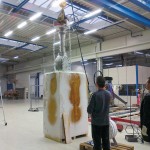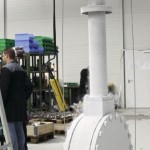A few months ago, Müller co-ax supplied several butterfly valves in different sizes and versions for a cryogenic application. Even the biggest of the four offset butterfly valves (DN 600 mm) was tested at maximum differential pressure at -196 °C with zero leakage.
The author: Dr. Gregor Gaida Vice President, Müller co-ax
LNG, liquid nitrogen and other cryogenic media are used at temperatures below -160 °C. The material employed for the piping and apparatus in these applications is not very specific and the requirements are not hard to fulfil. AD 2000 Part W10 contains a long list of materials that can be chosen for pressure parts at cryogenic temperatures. The flange seals between the piping sections are meanwhile also standard parts that are available from many different suppliers. The biggest problem are the valves. The material requirements and allowable yield strength are calculated according to the same criteria as for the piping. The stem seal is likewise a standard part. The critical factor relates to the tightness of the valves at cryogenic temperatures – not to the outside but along the pipe. This problem increases proportionally to the nominal diameter.
Problems at cryogenic temperatures
It may initially come as a surprise that valves which are absolutely tight at ambient or very high temperatures are so difficult to make leakproof at cryogenic temperatures. The leaks at these temperatures are caused by a physical effect which, contrary to normal scientific theory, certainly exists in practice. According to textbook teaching, homogeneous isotropic metal materials expand and shrink linearly with temperature and this expansion or shrinkage is independent of the wall thickness. The theory is that a round bore will remain round regardless of the temperature as long as the complete part is heated or cooled homogeneously. This theory states that the bore should remain round no matter whether the wall sections around it are constant or not. It has been proved correct for rising temperatures even up to the maximum of +1000 °C but is no longer applicable at low temperatures: at about -40 °C the metallic materials start to shrink in a non-linear way that varies depending on the wall thickness.
Triple offset butterfly valves
The seat surface of a triple offset butterfly valve is determined by the outside surface of a cone with a round bottom. Since this cone is cut at an angle which is not perpendicular to its axis, the seat opening is elliptical. This, and the fact that the outside diameter of the body is round, means that the wall sections of the triple offset butterfly valve can never be constant. The shorter axis of the elliptical seat is close to the bearings that hold the stem in the valve body. The wall section in this area is therefore thicker simply because the seat is smaller. Added to this, most products have more material in the bearing area even though there is no technical need for such a design.
The seal of the valve, which is normally laminated, has an elliptical outside shape corresponding to the seat. The bore inside the lamination is round in all products available in the market. As a result, the seal wall is thickest at the point where the wall of the valve body is thinnest and vice versa. Together with the physical effect of non-linear shrinkage at lower temperatures, this causes the body to shrink most in those areas where the seal shrinks least and vice versa. Valves – and especially butterfly valves with a triple offset design – which are perfectly tight at ambient temperatures consequently find it most demanding to meet the criteria of British Standard 6364, which specifies a maximum leakage rate of 3600 ml/min for a 600 mm valve.
Difficult compromise
The laminated seal of a triple offset butterfly valve has to perform more than one function. The principal aim of zero leakage tightness can only be achieved if the lamination is sufficiently flexible and soft to seal even minimal surface roughness on the conical seat. The seal must also be able to withstand the forces which are produced if the valve is closed and the full differential pressure is applied to the disc. The third function of the laminated seal is a limit stop for the butterfly valve. It must be capable of stopping the actuator when the valve is moved into the closed position. The design engineer is forced to find a compromise that satisfies all three requirements. The seal has to be soft and flexible to ensure bubble-free tightness yet strong and rigid enough to withstand the forces created by differential pressure when the valve is closed as well as additional forces due to the torques of the actuators. Experience shows that this compromise is particularly hard to fulfil with bigger sizes and larger pressure differences. The challenge is even greater if a triple offset butterfly valve has to be used at cryogenic temperatures.
Four offset butterfly valve design
The unique, patent pending design of the Quadax four offset butterfly valve allows designers to use seals without being constrained by the traditional compromises that would be inevitable if laminated seals were used as they are in triple offset butterfly valves. Thanks to the four offset design, the seal can be based on the usual criteria, in other words it can be very soft and flexible. The standard Inconel O-ring can be used as a pure metal seal without being forced to resort to softer materials like graph-ite. The four offset design simultaneously allows all the forces and torques which would normally act on the laminated seal as loads to be applied to a solid, rigid stainless steel disc.
Moreover, the Quadax body was deliberately designed such that the wall sections all around it are identical. The wall sections of the seal itself are, of course, likewise absolutely identical. Even in the bearing area, there is no additional material in the valve body. As a result, the shrinkage behaviour both in the seal and in the seat is the same – and symmetrical – all around the valve. The Quadax achieves perfect tightness in this way, even with very large diameters.
The sensitivity of cryogenic applications and tests can be illustrated with an example that was encountered during the last approval.
One of the tested valves was leaking. It was tight according to British Standard 6364 but failed to meet our expectations by a long way. The valve was removed from the liquid nitrogen and the blind flange opened. Everyone knows that humidity in the air will ice on very cold metallic surfaces and that the layer can sometimes be very thick. The only modification to the tested valve was that it was opened and the ice wiped off the seal and seat surface. It was then absolutely tight, as witnessed both by the customer’s agent and by a third party (Bureau Veritas).
Hall 8.0, Booth H9
cpp-net.com/0212406
Share:









